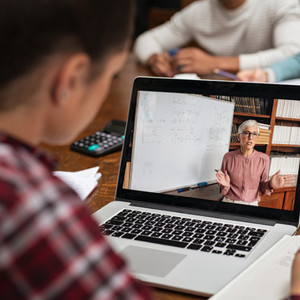Internet Safety in an Online Classroom
Online teaching creates countless opportunities for using technology in the classroom and unlocks new avenues for engaging students. Even once the pandemic is over and classes resume full face-to-face instruction, many teachers plan to continue incorporating technology into their curriculum.
Technology can be a fantastic resource for teachers, especially during the COVID-19 pandemic. However, it’s critical teachers understand the importance of internet safety in an online classroom. Teachers need to learn about what technology they’re using in the classroom, the different kinds of threats that exist on the internet, and how to protect students from danger.
For example, online predators can hack into a virtual classroom and chat with students or “Zoom bomb” with racist or pornographic images. Simple steps such as knowing how to create a password for an online classroom can protect students from danger.
Internet safety isn’t just about outside predators. An often overlooked threat is the one that comes from within a classroom: cyberbullying. Chatrooms, text messages, and social media are all opportunities for bullies to harass and humiliate their peers. Teachers can learn to take measures such as knowing how to disable chat features in a virtual classroom and ensure that remote school is safe for every student.
Teachers can empower students to be responsible for their own digital awareness and behavior through the implementation of internet safety guidelines.
The most important part of the guidelines is what goes into it. To make it straightforward for students, teachers can use the SMARRT method to frame the guidelines. The acronym SMARRT helps teachers to remember the key rules that ought to be included in the guidelines, such as:
Safety Rules: This includes the safety actions for students to follow, such as:
- Protect devices using passwords.
- Do not divulge personal information and passwords to others.
- Refrain from posting information and pictures which may be exploited by others.
- Refrain from reacting or responding to any digital attacks.
- Save evidence of any online abuse.
Meet: Students should avoid meeting online strangers in real life. If any individual attempts to solicit a student for such encounters, students should inform their parents.
Accept: Students should be careful when accepting or opening:
- Emails or messages from unknown sources.
- Downloading pictures or files from unknown sources, which may contain malware that can corrupt devices.
- Friend requests from unknown individuals.
Reliability: Not all information found online is reliable. Students should consider this when:
- Accessing different websites and social media platforms.
- Purchasing or downloading applications or games.
Respect: Just as in real life, students should remember to respect others in the digital world. They should refrain from:
- Using inappropriate language on social media or in a virtual classroom
- Posting or forwarding information that might embarrass, threaten, or hurt others.
- Engage in bullying behavior or support bullies.
Tell: Inform parents and teachers about any unwanted or inappropriate contact or actions faced online.
Commitment to following these rules can keep students safe online and provide them with a positive digital experience.
Some food for thought:
- How do you balance technology and internet safety in an online classroom?
- Do you have internet safety guidelines for your students?
Internet safety is more important than ever before. Explore more with the online PD course: Internet Safety in a Connected World.
 About the Author
About the Author
Ellen Paxton is a respected expert in education and best known as the Chief Learning Officer of Professional Learning Board. As a two-time National Board Certified Teacher, Ellen has successfully published and customized online professional development courses and Learning Management Systems for 20 years to help teachers meet their state continuing education renewal credit requirements. Through ProfessionalLearningBoard.com, RenewaTeachingLicense.com, and ConnectedPD.com. Ellen has established solutions and maintained partnerships with several accredited universities, higher education institutions, teachers’ unions and state Departments of Education while setting strategic direction that makes a difference and overseeing implementation of popular online PD.

Comments are closed.